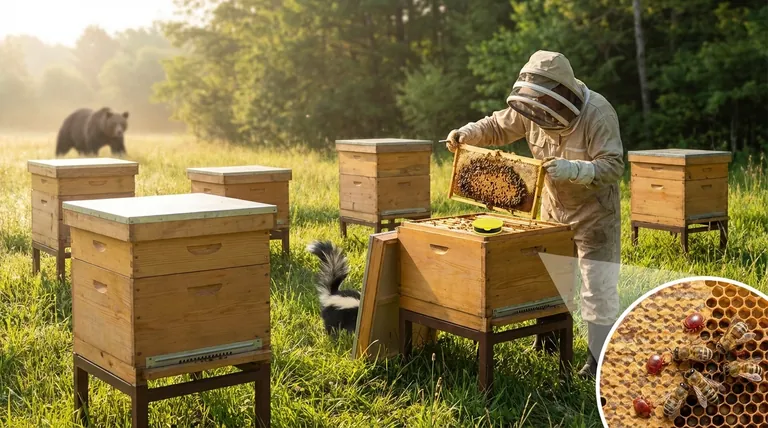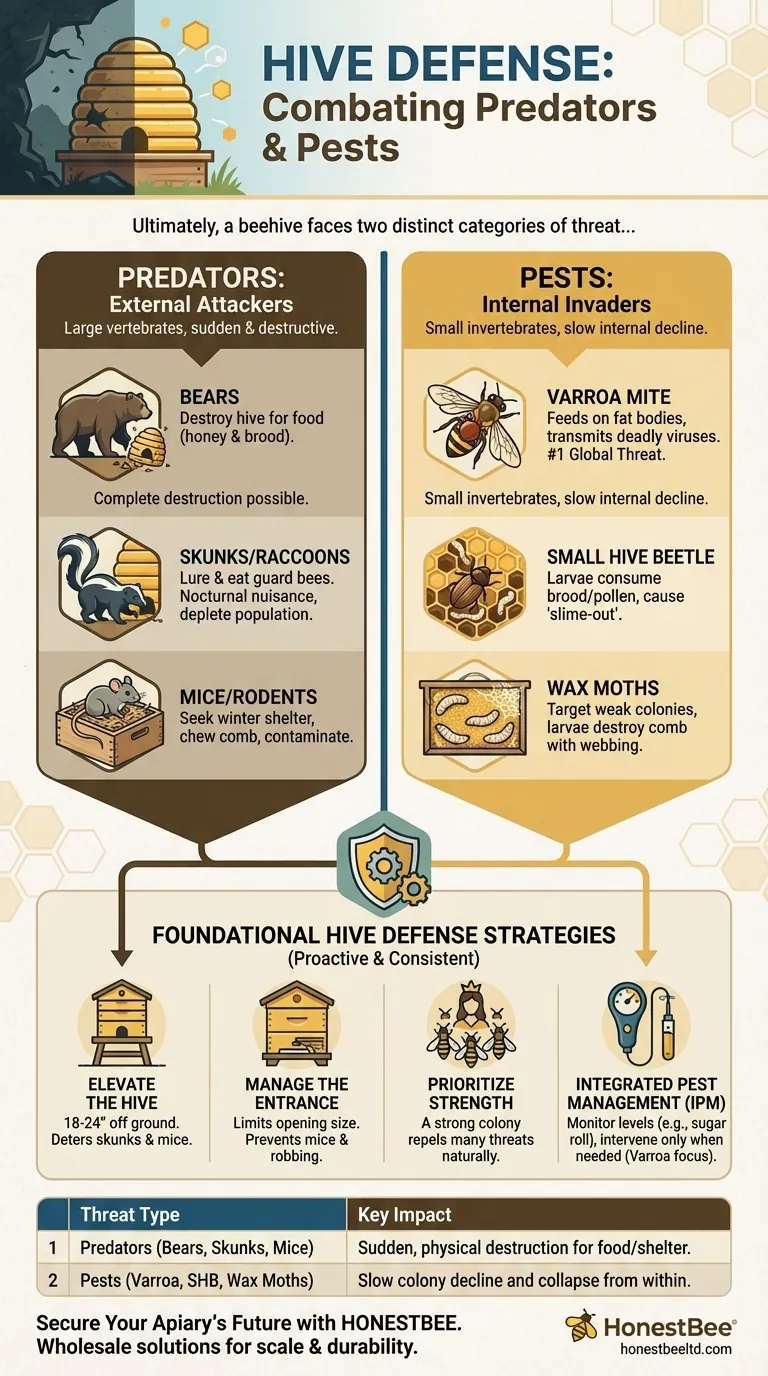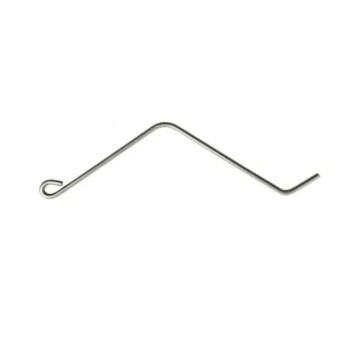Ultimately, a beehive faces two distinct categories of threat: large vertebrate predators that attack the hive for food, and smaller invertebrate pests or parasites that infest it from within. Common predators include bears, skunks, and mice, which seek honey, brood, or shelter. The most significant pests are invasive species like the Varroa mite and the small hive beetle, which weaken and destroy the colony from the inside out.
Understanding the nature of the threat is the first step toward effective defense. Your primary goal is not to create an impenetrable fortress, but to implement simple, consistent practices that make your hive an unattractive and difficult target for these opportunists.

Predators vs. Pests: Know Your Enemy
A successful defense strategy begins with properly identifying the type of threat you are facing. Predators and pests operate differently and require distinct management approaches.
Predators: The External Attackers
Predators are typically vertebrates seeking a high-energy food source. Their attacks are often sudden, direct, and destructive.
Bears are the most formidable predator, capable of completely destroying a hive to consume the honey and, more importantly, the protein-rich brood.
Skunks and Raccoons are nocturnal nuisances. They scratch at the hive entrance to lure out and eat individual guard bees. While one visit is minor, repeated attacks can significantly deplete a colony's population over time.
Mice and other Rodents are winter opportunists. They do not typically eat the bees but seek the hive's warmth and shelter. Once inside, they chew through comb, urinate on surfaces, and contaminate the space, often causing the colony to abscond or perish from stress.
Pests: The Internal Invaders
Pests are invertebrates that live, feed, and reproduce inside the hive. They are often a greater long-term threat than predators because they undermine the colony's health from the inside, leading to a slow decline and collapse.
The Varroa Mite (Varroa destructor) is universally considered the single greatest threat to honey bees worldwide. This external parasite attaches to adult bees and developing brood, feeding on their fat bodies. This feeding weakens the bees and, critically, transmits a host of deadly viruses.
The Small Hive Beetle (Aethina tumida) is an invasive scavenger. Adult beetles lay eggs in the hive, and their larvae burrow through comb, consuming brood, pollen, and honey. During this process, they defecate in the honey, causing it to ferment and run out of the hive in a characteristic "slime-out."
Wax Moths (Galleria mellonella) are pests of opportunity, primarily targeting weak or dead colonies. Their larvae consume beeswax, pollen, and bee cocoons, leaving behind a thick webbing that destroys combs. A strong colony can typically manage and eject wax moths on its own.
Foundational Hive Defense Strategies
The best defense is a proactive one. Several fundamental beekeeping practices can deter the vast majority of threats.
Elevate the Hive
Placing your hive on a hive stand is the simplest and most effective first step. Elevating the hive 18-24 inches off the ground makes it difficult for skunks to comfortably reach the entrance and makes it harder for mice to find their way in. It also improves air circulation, creating a less hospitable environment for pests.
Manage the Entrance
Using an entrance reducer, especially in the fall and for newer colonies, limits the size of the opening the bees must defend. This is highly effective at preventing entry by mice and helps the colony guard against robbing wasps and bees from other hives.
Prioritize Colony Strength
A populous, healthy, and queenright colony is its own best defense. Strong hives have enough workers to repel predators, remove pests like wax moths, and manage a low-level infestation of small hive beetles. All management practices should be aimed at maximizing colony health.
Practice Integrated Pest Management (IPM)
IPM is a strategy focused on monitoring pest levels and intervening only when they cross a damaging threshold. For Varroa mites, this involves regular monitoring (e.g., via a sugar roll or alcohol wash) and applying appropriate treatments. This prevents the unnecessary use of chemicals and prioritizes the long-term health of the bees.
Understanding the Trade-offs
No defensive solution is perfect. Acknowledging the limitations of each approach is crucial for making informed decisions.
The Cost of Physical Barriers
An electric fence is the only truly reliable defense against bears. However, it represents a significant financial investment and requires regular maintenance to ensure it remains energized and clear of vegetation.
The Risk of Chemical Treatments
Treatments for Varroa mites are essential for hive survival in most regions. However, these miticides are, by definition, pesticides. If applied incorrectly, at the wrong time of year, or against label directions, they can harm the bees or contaminate the honey.
The Effort of Vigilance
Effective pest management is not a "set it and forget it" task. It requires consistent hive inspections to monitor colony strength, check for signs of disease, and quantify Varroa mite levels. This commitment of time and effort is the primary cost of responsible beekeeping.
Making the Right Choice for Your Goal
Your defensive strategy should be tailored to the specific threats in your area and the goals you have for your bees.
- If your primary concern is large predators (like bears): Your first and most critical investment must be an electric fence, as other methods will ultimately fail.
- If you are dealing with smaller nocturnal pests (skunks, mice): Elevate your hives on a sturdy stand and use an entrance reducer in the fall and winter.
- If your goal is long-term colony survival (all beekeepers): You must create and follow a robust Varroa mite management plan, as uncontrolled mites are the leading cause of colony death.
- If you are just starting out: Begin with a solid hive stand and learn to perform regular hive inspections. Early detection is the key to managing almost any problem.
Proactive monitoring and consistent management are the core principles that separate a struggling hive from a thriving apiary.
Summary Table:
| Threat Type | Common Examples | Primary Goal | Key Impact |
|---|---|---|---|
| Predators | Bears, Skunks, Mice | Destroy hive for food/shelter | Sudden, physical destruction |
| Pests | Varroa Mites, Small Hive Beetles | Infest and weaken from within | Slow colony decline and collapse |
Secure Your Apiary's Future with HONESTBEE
Protecting your investment requires the right equipment and strategies. At HONESTBEE, we supply commercial apiaries and beekeeping equipment distributors with wholesale-focused solutions designed for scale and durability. From robust hive stands and entrance reducers to integrated pest management tools, our products help you implement the proactive defenses outlined in this article.
Let us help you build stronger, more resilient colonies. Contact our expert team today to discuss your wholesale beekeeping supply needs.
Visual Guide

Related Products
- Adjustable Formic and Acetic Acid Dispenser for Bee Mite Treatment
- HONESTBEE Advanced Ergonomic Stainless Steel Hive Tool for Beekeeping
- Professional Dual-End Stainless Steel Hive Tool for Beekeeping
- Professional Galvanized Hive Strap with Secure Locking Buckle for Beekeeping
- Beekeeping Gloves Goatskin Leather with Long Cotton Sleeve for Beekeepers
People Also Ask
- What are phoretic mites? A Beekeeper's Guide to Monitoring Varroa Infestation
- What should beekeepers do to manage varroa mites effectively? Adopt a Proactive Monitoring Strategy
- How do Varroa mites spread between honey bee colonies? Stop Mite Transmission in Your Apiary
- How can beekeepers ensure their hives survive the winter? A Guide to Colony Survival
- What are the symptoms of Varroa Mite Syndrome (VMS)? Recognizing the Signs of Colony Collapse



















